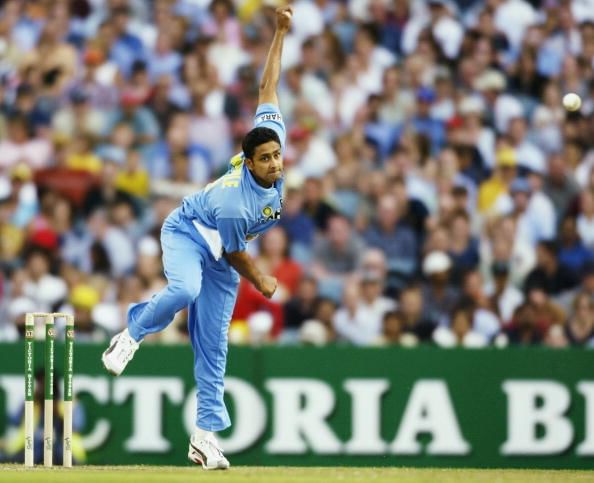
World Cup History: Anil Kumble - the enigma who vanquished the doubters
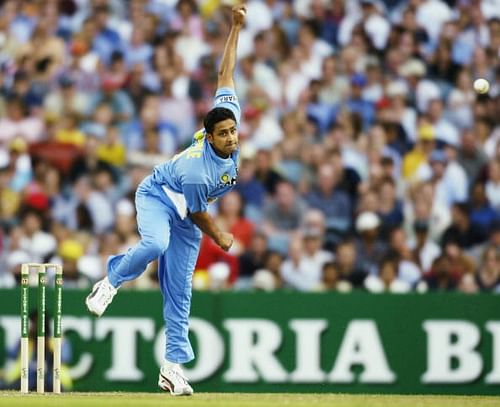
For a long time, Anil Kumble was somewhat of an enigma. He was a scourge on home wickets in India, where the ball generally grips the turf and afforded him just enough turn to beat the batsman. At the same time, he was relatively unsuccessful overseas with his quickish wrist-spin.
That India had a poor record away from home over a long period was in part somewhat linked to Kumble’s inability to strike on wickets not amenable to spin. Even so, he made a tremendous contribution to Indian cricket which, over the years, often turned solely to him to carve out victories.
Challenges faced by even the greatest
We must also not forget that the peerless Shane Warne failed on Indian pitches and against Indian batsmen. The legendary Dennis Lillee found to his chagrin that it is very difficult to get wickets on the slow, flat tracks of Pakistan. His fearsome partner Jeff Thomson did not relish bowling on the softer English wickets. Doug Walters, a brilliant strokeplayer at home, also found batting difficult on the decks of England where the ball did not bounce as much as he liked.
These are four top-class Australians who have represented world-beating teams. Even the greats struggle sometimes in conditions not suitable to their craft. Let not Kumble, a modern giant among spinners, be singled out.
The thinker and the fighter that he is, the blemish in his resume was certainly not lost on Kumble. He continued to strive and ultimately learnt to vary his flight and pace, mastered the googly, and added guile to the accuracy and venom that he always had. The added potency, allied to the emergence of young pacemen, made India a force to reckon with overseas too.
In addition to his fine bowling in the World Cup, Kumble scored with his fielding, or more specifically, catching. He took the highest number of 8 catches in the 1996 tournament and is joint-eighth in the all-time list with 14 catches in 18 matches. With the ball, he conjured up many tricks that left batsmen perplexed.
Kumble's World Cup journey begins in 1996
Kumble first appeared in the World Cup in 1996 and immediately mesmerised the innocents from Kenya. He picked up his first wicket when he beat Maurice Odumbe on the forward stroke and had him stumped by Nayan Mongia. Having thus broken the Kenyan captain’s 96-run third-wicket stand with Steve Tikolo, Kumble went on to dismiss Hitesh Modi and Thomas Odoyo cheaply. Kenya went into a decline as Kumble finished with three for 28 off his 10 overs.
The West Indies middle-order felt the heat of his sizzling spinners. He castled Roland Holder for a duck and repeated the dose on Roger Harper and Otis Gibson. He took three for 35 in 10 overs as the Indian attack stunted the Caribbean innings.
In the hammering at the hands of an emergent Sri Lanka, Kumble was one bowler who made some impression on the marauding batsmen. He put a halt to the plunder by Sanath Jayasuriya, having him taken in the deep by Manoj Prabhakar. Soon he beat Aravinda de Silva in the flight to have him stumped by Mongia. That had the Sri Lankans worried but skipper Arjuna Ranatunga and Hashan Tillekeratne calmly carried them to the stiff target. Kumble conceded just 39 runs for his two wickets in 10 overs in the high-scoring match.
The Zimbabweans too found him difficult to score off as he took two for 33 off 9.4 overs.
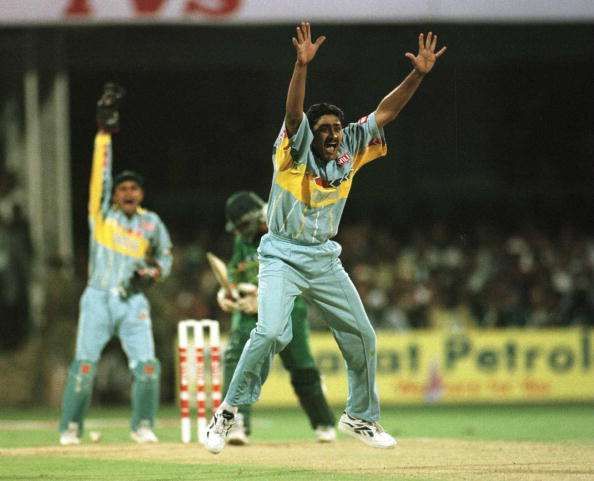
Kumble played a key role in the dramatic quarter-final. After Venkatesh Prasad had stung the Pakistanis with three wickets, Kumble caused further injury. He trapped Salim Malik leg-before, breaking the 52-run fifth-wicket partnership with old warhorse Javed Miandad. As Miandad battled on, Kumble continued to snipe at the batsmen. He deceived Mushtaq Ahmed into hitting the ball back to him.
Miandad was then run out, and he walked away from the international arena for the last time. The farewell cheers for Miandad had barely died down when Kumble trapped Ata-ur-Rahman leg-before. Kumble finished with three for 48 off 10 overs as India stormed into their third semi-final in four successive World Cups.
The semi-final petered out like a firecracker that refuses to burst and just fizzles out even as onlookers watch in anticipation of it exploding in a blaze of light and sound. Kumble failed to make much impression on the Sri Lankan batsmen though he dismissed the brilliant Aravinda de Silva who played a superlative knock in the shadow of stunning early reverses at the hands of Javagal Srinath. Nevertheless, Kumble’s tally of 15 wickets was the highest in the tournament, to go well with his 8 catches.
India's indifferent show in the 1999 World Cup
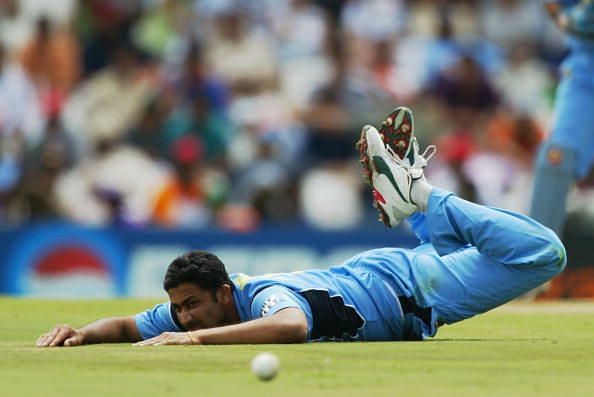
The cold and damp climate in late spring and early summer in England has never been kind to spinning fingers, and wrists. So was it for Kumble in 1999. He took two for 41 in a distressing defeat at the hands of Zimbabwe, dismissing Alistair Campbell and Guy Whittall in quick succession.
As India fought back to beat hosts England in the last league match, Kumble knocked the fight out of the middle-order by trapping both Andrew Flintoff and Adam Hollioake leg-before. He took two for 30 in 10 overs.
Kumble backed up pacemen Srinath and Prasad as India achieved yet another World Cup victory over Pakistan. He surprised Azhar Mahmood with his bounce and had him snapped up by Mongia. That left Pakistan reeling at 78 for five. Finally, Kumble foxed Saqlain Mushtaq, trapping him leg-before as the Pakistani chase tapered out once again. His final tally was two for 43 off 10 overs. That was the last spark before the Indian challenge faded in the tournament.
Batsmen fathomed Kumble's predictable bowling
As batsmen around the world increasingly fathomed his predictable top-spin, Kumble did not innovate by developing newer deliveries. Warne and Muttiah Muralitharan prospered in the business because they found new tricks.
The emergence of Harbhajan Singh also left little room in the team, particularly when only one spinner was needed. Consequently, Kumble played only three matches in the 2003 World Cup.
Ironically, he bagged his best haul of four for 32 in the event against Holland but was relegated to the bench for the best part of the tournament. That must have hurt, for we saw a newer version of Kumble after that. He became a more complete bowler and succeeded in overhauling Kapil Dev’s record tally of Test wickets for India.
The 2007 World Cup was a disaster for India and Kumble got to participate only in the picnic with the rookies from Bermuda. He duly picked up three wickets for 38 in 9.1 overs.
The gangly, bespectacled, unathletic spinner scaled unimagined heights
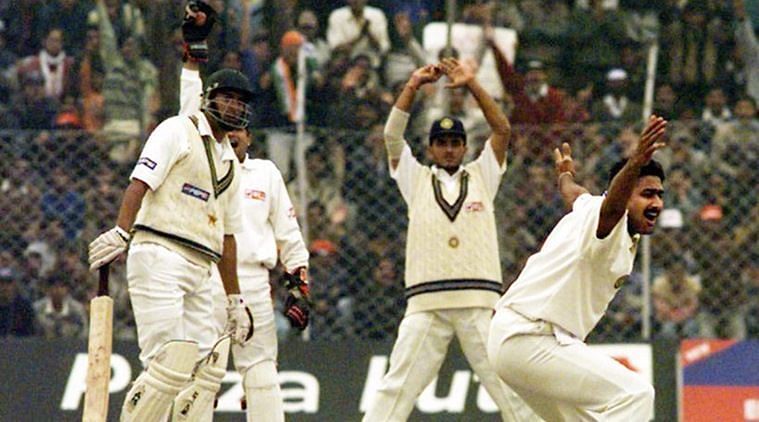
When Kumble began his international career in 1990, who would have thought that a spinner who could not turn the ball, would finish with more than 600 wickets in Test matches, only behind the immortal Muralitharan and Warne, and over 300 wickets in one-day internationals?
To add lustre to these achievements is his feat of capturing all 10 wickets in a Test innings, only the second man to do so after the English off-spinner Jim Laker. That he touched such heights is a tribute more to his determination than the natural gifts that he was blessed with. Kumble is an inspiration to those who strive on and on and achieve wonders by sheer dint of hard work.
Kumble has etched his name alongside the finest spinners in history. The lasting image is of him wheeling away his accurate wrist-spinners in a tangle of arms and legs.
The popular perception would be that he ranks among the most economical spinners. The irony is that all his top leg-spinning rivals in the World Cup - Abdul Qadir, Mushtaq Ahmed and Shane Warne - have slightly better economy-rates. That is not easy to figure out. And those are the vagaries of cricket.
Anil Kumble’s World Cup record:
Matches 18, Wickets 31, Average 22.83, Best 4/32, Economy 4.08, Catches 14